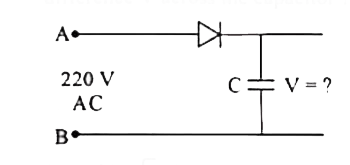
A 220 V A.C. supply is connected betweeen points A and B (See figure). What will be the potential difference V acorss the capacitor ? Solution in Gujrati
200V
110 V
0 V
V
The correct Answer is:D
In the given figure, applying Kirchhoff.s second law in the closed loop containing A.C. source, ideal diode and capacitor, we can write at time t,
Resistance of ideal diode in forward biased condition is and so,
volt
Resistance of ideal diode in reverse biased condition is and so taking I = 0, from equation (1),
volt
Topper's Solved these Questions
- SEMICONDUCTOR ELECTRONICS : MATERIALS, DEVICES AND SIMPLE CIRCUITS BOOK - KUMAR PRAKASHANCHAPTER - SEMICONDUCTOR ELECTRONICS : MATERIALS, DEVICES AND SIMPLE CIRCUITS EXERCISE - Section-C: NCERT Exemplar Solution (Multiple Choice Qustion (More than One Options))
8 Videos
- SEMICONDUCTOR ELECTRONICS : MATERIALS, DEVICES AND SIMPLE CIRCUITS BOOK - KUMAR PRAKASHANCHAPTER - SEMICONDUCTOR ELECTRONICS : MATERIALS, DEVICES AND SIMPLE CIRCUITS EXERCISE - Section-C: NCERT Exemplar Solution (Very Short Answer Type Questions)
6 Videos
- SEMICONDUCTOR ELECTRONICS : MATERIALS, DEVICES AND SIMPLE CIRCUITS BOOK - KUMAR PRAKASHANCHAPTER - SEMICONDUCTOR ELECTRONICS : MATERIALS, DEVICES AND SIMPLE CIRCUITS EXERCISE - Section-B : Numericals (Numerical From .DARPAN. Based On Textbook)
14 Videos
- SAMPLE QUESTION PAPER BOOK - KUMAR PRAKASHANCHAPTER - SAMPLE QUESTION PAPER EXERCISE - PART-B SECTION-C
5 Videos
- WAVE OPTICSBOOK - KUMAR PRAKASHANCHAPTER - WAVE OPTICSEXERCISE - SECTION-D (MULTIPLCE CHOICE QUESTIONS (MCQS)) (MCQS FROM DARPAN BASED ON TEXTBOOK)
239 Videos
Similar Questions
When an electric field is applied across a semiconductor
View SolutionWhy are elemental dopants for Silicon on Germanium usually chosen from group XIII on group XV ?
View SolutionA logic circuit is shown in the diagram. Draw the output signal at the point X and Y for the input signal shown in the figure at point A.

View SolutionTwo charges –q and +q are located at points (0, 0, –a) and (0, 0, a), respectively.
(a) What is the electrostatic potential at the points (0, 0, z) and (x, y, 0) ?
(b) Obtain the dependence of potential on the distance r of a point from the origin when r/a>>1 .
(c) How much work is done in moving a small test charge from the point (5,0,0) to (–7,0,0) along the x-axis? Does the answer change if the path of the test charge between the same points is not along the x-axis?
View SolutionAccording to particle theory of light what is the velocity of light in a dense medium, compared to that in rare medium ?
View SolutionTwo, capacitors A and B are connected in series across a 100V supply and it is observed that the potential difference across them are 60V and 40V. A capacitor of 2p.F capacitance is now connected in parallel with A and the potential difference across B rises to 90V. Determine the capacitance of A and B
View SolutionA 220 V AC supply is connected between points A and B . What will be the potential difference V across the capacitor ?

View SolutionWhat will be the instantaneous voltage for a.c. supply of 220 V at 50 hertz ?
View SolutionA 220 V ac supply is connected between points A and B as shown 220 V in figure. What will be the potential AC difference V across the capacitor?

View SolutionA 220 V AC supply is connected between points A and B. What will be potential difference across capacitor C ?
View SolutionA 220 V ac supply is connected between points A and B [Fig.1.51]. What will be the potential difference V across the capacitor?
(##CHY_DMB_PHY_XII_P2_U09_C01_E04_003_Q01.png" width="80%">
View SolutionA 220 V A. C supply is connected between points A and B as shown in figure what will be the potential differnece V across the capacitor ?

View SolutionA 220 V AC supply is connected between points A and B . What will be the potential difference V across the capacitor ?

View SolutionA 220 V ac supply is connected between points A and B as shown 220 V in figure. What will be the potential AC difference V across the capacitor?

View Solution220 V ac is connected between the power supply points A and B (Figure). What is the potential V at the ends of the capacitor?
View Solution
